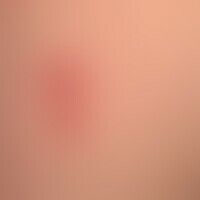Image diagnoses for "red"
876 results with 4456 images
Results forred

Tinea pedis (overview) B35.30
Tinea pedum. general view: Discrete, well-defined, heart-shaped, slightly scaly hyperkeratosis and erythema on the right foot back of an 80-year-old female patient with exacerbated tinea pedum.

Angiodysplasia Q87.8

Primary cutaneous cd30 positive large cell t cell lymphoma C86.6
Primary cutaneous CD30-positive large cell T-cell lymphoma: lymphoma known for alonger period of time with a faster growth tendency in recent months.

Dermatomyositis (overview) M33.-
dermatomyositis. chronic stationary, flat, red, "heliotropic" exanthema. typical pronounced periorbital paleness. general fatigue, muscle weakness.

Dyskeratosis follicularis Q82.8
Dyskeratosis follicularis (Darier's disease) Disseminated, yellow-brownish papules and plaques, sometimes covered with small crusts.

Ecchymosis syndrome, painful R23.8
ecchymosis syndrome, painful. intermittent manifestation of painful, demonstrably non-traumatic induced skin bleeding in a 61-year-old woman. initial pressure-sensitive erythema. subsequent development of skin bleeding and slow expansion of the skin changes. chronic recurrent course. no underlying disease known.

Dermatitis medusica L24.8
Dermatitis medusica: Acute, linear, itchy and burning (also painful) plaque, as well as disseminated, papules and vesicles, appearing on the thigh of a 32-year-old woman about 6 hours after contact with a fire jellyfish (Baltic Sea); the stripe pattern is evidence of exogenous triggering.

Purpura fulminans D65.x
Purpura fulminans: blistered lifting of the skin in the area of the left flank.

Keratoakanthoma (overview) D23.-
Keratoakanthoma, classic type: short term, grown within a few weeks, about 1.8 cm in diameter, hard, reddish, central keratotic nodule with bizarre telangiectasias on the surface, in a 71-year-old female patient.

Melanoma acrolentiginous C43.7 / C43.7
melanoma, malignant, acrolentiginous. reddish, partly skin-coloured, slowly growing, coarse plaque, which has predominantly displaced the nail bed. there are also bizarre, black-brown hyperpigmentations. the nail plate is no longer existent except for a rest.

Contagious mollusc B08.1
Molluscum contagiosum: Detailed enlargement: disseminated, 0.1-0.7 cm in size, firm, coarse, waxy, broadly seated, smooth, red papules, which are centrally dented on closer examination; sometimes itching; psoriatic suberythroderma.

Atopic dermatitis (overview) L20.-
extrinsic atopic dermatitis: eminently chronic, somewhat asymmetrical eczema with blurred, itchy, red, rough, flat plaques. known (only slightly pronounced) rhinoconjunctivitis allergica. I.A. variable course with activity spurts ("overnight"). IgE normal. no atopic FA.

Keratoakanthoma (overview) D23.-
Keratoakanthoma, classic type: short term, grown within a few weeks, about 1.8 cm in diameter, hard, reddish, central keratotic nodule with bizarre telangiectasias on the surface, in a 71-year-old female patient.

Basal cell carcinoma destructive C44.L
Basal cell carcinoma, destructive: ulcer measuring approx. 3 x 4 cm with glassy papules strung together like a string of pearls. 64-year-old female patient.

Psoriasis (Übersicht) L40.-
Psoriasis: Plaque type with anular formations. Massive scaling. No pre-treatment.

Linear IgA dermatosis L13.8
Linear IgA dermatosis: Ring-in-ring formations as an expression of relapsing activity.

Fixed drug eruption L27.1
Drug reaction fixed: red, sharply defined, little itchy plaques that have been present for several days; tendency to central blistering.

Basal cell carcinoma superficial C44.L
Basal cell carcinoma superficial: slowly growing, symptomless red plaque with a slightly marginalized structure and central crustal formations that has existed for several years.

Toxic epidermal necrolysis L51.2
Toxic epidermal necrolysis. detailed picture: The 67-year-old female patient developed multiple, acute, disseminated, sharply demarcated, partly confluent, soft, skin-coloured blisters on a flat erythema on the entire integument within a few days. In case of persistent fever, antibiotic therapy was initiated.





